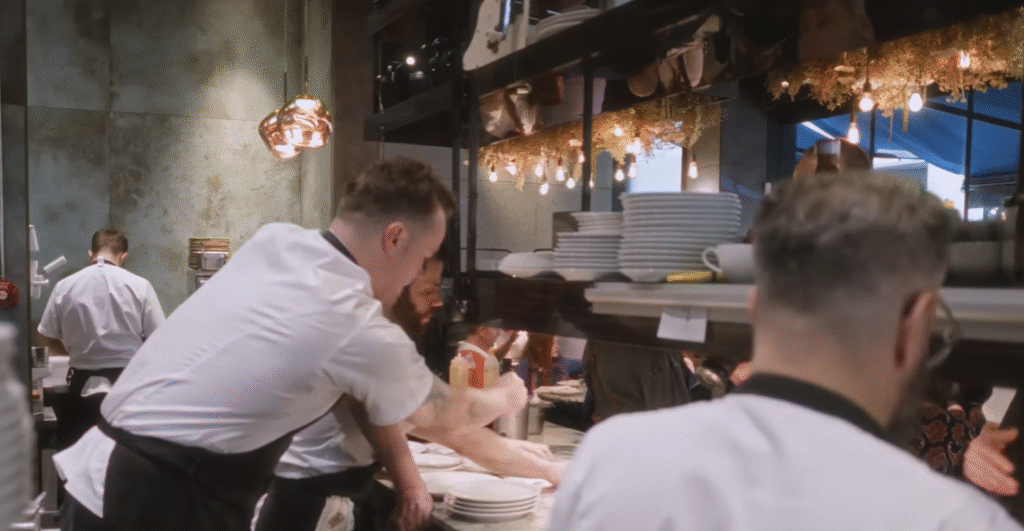Table – Top Open Kitchen Restaurants in the UK
| Restaurant Name | Location | Cuisine Type | Price Range | Standout Feature |
|---|---|---|---|---|
| Goldies | Soho, London | Wood-Fired Grill | ££££ | Counter seating with visible wood-fire action |
| Ember Yard | Soho, London | Spanish-Italian Tapas | ££££ | Custom Basque grill with open charcoal cooking |
| Lobos Meat & Tapas | Soho, London | Spanish Grill | ££££ | Flame-cooked meat-focused menu |
| Dehesa | Soho, London | Iberian Tapas | ££££ | Inspired by Spanish oakland charcuterie culture |
| Piccolino Heddon Street | Mayfair, London | Contemporary Italian | ££££ | Cicchetti bar and interactive open kitchen |
| 10 Greek Street | Soho, London | Seasonal European | ££££ | Compact, rotating menu with close kitchen view |
| Bar Kroketa | Soho, London | Spanish Street Food | £££ | Open kitchen with croqueta-centric tapas |
| Bottarga | Chelsea, London | Greek-Mediterranean | ££££ | Refined dishes in view of an open Aegean kitchen |
| The Lore of the Land | Fitzrovia, London | Elevated British Pub | ££££ | Rustic upstairs kitchen visible from all angles |
| OpenKitchen | Shoreditch, London | Creative European Fusion | ££££ | Culinary incubator with zero-waste initiatives |

A live theatrical performance is remarkably similar to dining at an open kitchen restaurant. Every plate conveys purpose in addition to ingredients. In London, the growing number of eateries emphasizing openness and style with exposed kitchens is not only in style, but also incredibly successful at increasing patron interaction.
The intimate, flame-forward dining experience at Goldies in Soho captivates the senses even before the menu is presented. Here, the chefs use fire to tell stories in addition to cooking. The restaurant creates a very immersive atmosphere by placing counter seats around a glowing wood-fired grill. Guests are drawn into the rhythm of the kitchen by the aroma of sizzle and smoke. The emotional bond between the diner and the dish is significantly enhanced by this sensory overture.
Ember Yard, which is only a short stroll away, expands on this open-fire concept using Basque methods and superb local wood. The tiny plates, such as roasted aubergines or smoked beef, leave a profoundly fulfilling impression, and the chefs work in close proximity, regulating temperatures with ancient accuracy. The eatery serves as a link between the past and the present by fusing traditional techniques with urban vitality.
Lobos Meat & Tapas takes things a step further with its unreservedly carnivorous philosophy. Cooking becomes a primal spectacle in their open kitchen. The closeness to the heat makes the meal feel very intimate, whether it’s lamb shoulder seared to a crusty finish or Iberico pork sizzling over flame. Seeing a dish come to life in front of diners is especially advantageous because it builds trust, increases anticipation, and removes uncertainty.
The Dehesa experience is equally remarkable. It honors the cultural heritage of cured meats and earthy cuisine by taking its name from the Spanish dehesa woodlands. The open kitchen is still a key component of the room’s character even though it isn’t theatrical. Watching chefs transform simple ingredients with elegant restraint—such as spooning rich romesco onto plates or thin-slicing charcuterie—has a calming effect. The guests’ taste is subtly influenced by the visual proximity—every detail feels taken into account.
Piccolino’s Heddon Street location across town in Mayfair adds Italian sophistication to the experience. The chef’s intentions and the diners’ tastes are constantly in conversation because the kitchen opens directly onto the dining area. Visitors are invited to observe delicate preparations such as zucchini fritti or beef carpaccio at their cicchetti bar. The design is opulent and hospitable, with a very clear goal of making fine dining more accessible.
The atmosphere is more relaxed but just as captivating at 10 Greek Street. Although the dining area is small, the open kitchen’s vibrancy amplifies the energy. Because of the constantly changing menu, every night feels unique. Seeing chefs create on the spot, such as preparing scallops with fennel or creating desserts on the spot, gives the evening a vibrancy that is rarely found elsewhere. The way it encourages spontaneity without compromising control is especially inventive.
A more laid-back interpretation is provided by Bar Kroketa. The open kitchen’s playful energy highlights their emphasis on croquetas, which are crispy, creamy, and varied. Visitors can watch as basic ingredients like jamón or wild mushrooms are transformed into delectable morsels. The experience is surprisingly inexpensive without sacrificing charm thanks to the laid-back atmosphere and the kitchen’s visibility.
With its sea salt air and Aegean soul, Bottarga in Chelsea is a showcase of Greek-Mediterranean refinement. Just enough visibility is available in their semi-open kitchen to be intriguing without overpowering the calm design. Calmly and elegantly, dishes like lemon-spritzed lamb or chargrilled octopus are prepared. As an illustration of how open kitchens can be executed in a variety of ways, the open design subtly improves the atmosphere.
Renowned filmmaker Guy Ritchie helped curate The Lore of the Land, which combines modern craftsmanship with pub culture. Guests can savor both British classics and sophisticated specialties like confit duck or wild venison stew thanks to the seamless integration of its open kitchen upstairs. The format is incredibly dependable and offers comfort with contemporary elements. Visibility is a component of the narrative here, not a ploy.
The most progressive example is probably Shoreditch’s OpenKitchen. It pushes the idea into socially conscious territory by serving as a restaurant and a training ground for chefs. By rotating up-and-coming chefs, the restaurant not only reduces waste but also increases exposure for talent. OpenKitchen provides a particularly transformative dining experience by fusing sustainability and transparency. It’s simply energizing to watch a young chef plate a zero-waste tasting menu and explain the sourcing strategy.
The feeling of shared momentum is what ties the experience together across these locations. Chefs are held more accountable, diners feel more connected to the source of the food, and hospitality becomes reciprocal. The open kitchen emphasizes performance, accuracy, and trust in addition to aesthetics. This degree of transparency has evolved into a cultural movement rather than a passing fad in recent months as diners look for deeper meaning in their meals.
